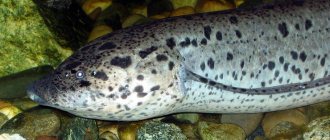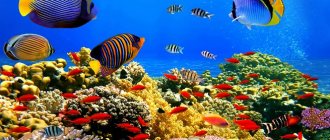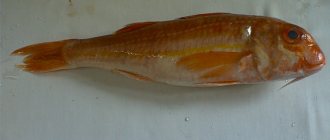Where it lives, what it looks like and description of the species:
Its habitat covers the territory from Central and Southern Siberia to Europe. In Europe, its habitats reach the south of the Pyrenees and the Alps; in Northern Scandinavia, Italy and Greece it is completely absent.
According to the IUCN Red List, this fish is native to the following countries:
Austria, Belarus, Belgium, Czech Republic, Denmark, Estonia, Finland, France, Germany, Italy, Kazakhstan, Latvia, Liechtenstein, Lithuania, Luxembourg, Moldova, Netherlands, Norway, Poland, Russian Federation, Slovakia, Sweden, Switzerland, Ukraine and UK .
Its habitat often coincides with the places where grayling and trout live, like them, it loves rivers with fast currents and rich oxygen content. One of the conditions for its residence is the presence of sandy - gravel soil at the bottom of the reservoir. It does not tolerate cold or warm water well (maximum 28 °C), and is rarely found above 650 m above sea level. Very demanding about the purity of water in the reservoir.
Very rare, but it can be found in small ponds and swamps or even in the coastal brackish water of the Baltic Sea. Can be found in large lakes provided they have access to fresh running water.
The gudgeon is a schooling river and bottom inhabitant of a reservoir; it always lives in a group, being at the bottom of the reservoir. Mainly nocturnal.
There is a subspecies of gudgeon that is found strictly in a limited area, this is the Dniester long-whiskered gudgeon (Gobio kessleri), found only in the Balkans and Eastern Europe, differs from the ordinary gudgeon by longer antennae and noticeable blue spots under or above the lateral line.
Photo of the common gudgeon, side view
Characteristic:
- Carp family, Pescari genus;
- Body size ranges from 8 to 15 cm, the largest recorded specimen was about 20.0 centimeters long and weighed 220 grams. But this is rather an exception, the normal length of his body is about 12.0 centimeters, the maximum body weight is 100 grams;
- The water temperature required for a comfortable life is from 17 to 22 ° C;
- Requires high oxygen content in water;
- The maximum age of life is about 5 – 8 years;
We recommend: Burbot, where it lives, when to catch it, behavioral characteristics
It has a slender, almost round body, a flattened, blunt muzzle with large eyes. The mouth is located at the bottom of the mouth, and a pair of whiskers is located at the edge of the upper jaw.
The color of the back is from dark brown to olive, the ventral side is white, the sides are lighter with a longitudinal row of up to 11 dark, bluish shimmering spots. The dorsal, caudal and anal fins have many small dark spots
Along the lateral line, small flickering spots of irregular shape from bluish to violet are visible.
The scales are quite noticeably shaded by small colored pigments; the fish has a gray metallic sheen. Along the lateral line there are dark gray-blue spots, the fins are relatively transparent.
Photo: Minnow on the bottom, close-up
How to raise minnows?
If you understand anything about fishing, then you know that the whole secret of successful fishing is in the right bait. You can’t find a single fisherman who hasn’t baited her hook with a minnow at least once. Fish farms also use minnows as live food for the larger fish they raise. In most cases, they breed them for this purpose. If you are interested in raising minnows for personal use or for sale, then you should know how to organize everything correctly.
1. Select a tank to hold your minnows. Your choice should depend on how many minnows you want to keep and where you plan to place the tank. If you plan to have only a few pieces, then a home aquarium is quite suitable for this. If the number of fish is greater, then, accordingly, a much larger tank will be needed. But no matter the size of the vessel, wash it with soap and water and rinse thoroughly.
2. Fill the reservoir with clean, non-chlorinated water. You can use filtered water. If you still need to somehow get rid of chlorine, then special drops or tablets will come to the rescue. Read the instructions carefully before using them. It is also very important to always maintain the water at the same level, as they did at the camp site here, which is optimal for active recreation.
3. Place objects at the bottom of the tank into which female minnows can spawn. This can be an ordinary clay pot or a composition of stones in the form of a cave, which can be bought in almost any store. Now it's time to plant your plants, if that's what you were planning on doing.
4. Choose an aeration device that best suits your needs. Aeration devices come in different sizes and types. Some of them enrich the water with oxygen, drawing it through a pump and pushing it to the surface, others release water through a sprayer, which is placed at the bottom of the tank, and the air rises up in the form of small bubbles. There are aeration devices that operate not only on electricity, but also on solar energy.
5. Buy or catch minnows that you want to use as breeders. Minnows may be caught in a trap or net from local streams or lakes. They can also be purchased from bait shops or fish farms. If none of the listed options suits you, go to the Internet sites.
6. Adapt minnows before placing them in a new home. This will allow the fish to acclimate to the tank water and reduce their stress. Adaptation is carried out by adding approximately 1 liter of new water from the tank to the container in which the minnows are located. Continue adding one liter of water at a time until the water in the container is the same temperature as the water in the reservoir. After this, carefully move the fish into the prepared tank.
7. Feed your minnows two to three times a day. In nature, minnows feed primarily on bottom-dwelling organisms, but feeding them in captivity will require the purchase of fish flakes and high-fat ingredients that can be purchased at fishing stores. Some breeders prefer to feed their minnows frozen brine shrimp, while others only feed them oatmeal.
Share with friends:
Date of publication: 03.12.2015
Add a comment Cancel reply
Lifestyle
The common gudgeon lives in large schools and feeds on bottom-dwelling animals. In the spring, it rises from the wintering grounds from lakes to rivers to lay eggs in May or early June. In autumn it returns to the lakes.
These fish are usually active during the day, but after any encounter with a predator or danger, they may permanently stop going out during the daytime and become completely nocturnal.
Depending on activity level and temperature, and during the breeding season, minnows can make squeaking sounds.
What does it eat?
A special feature of the gudgeon is that it has a pair of antennae, with which it can feel the bottom and look for food. Its diet consists of small soil animals (worms, crustaceans, insect larvae). Rarely, it can eat the eggs of other fish and plant foods. Does not disdain carrion.
In the wild, it feeds mainly at the bottom, but when kept in captivity, it can be easily accustomed to feeding in different layers of water, the main condition being the absence of predators in the neighborhood.
In winter, unlike some other fish, it continues to actively feed.
Photo: Caught minnow
Fishing:
Almost no one is intentionally fishing for gudgeon, except for some connoisseurs of its meat, which has good taste. For fishermen, the common gudgeon is valuable as live bait for catching pike, pike perch, perch, trout and other predatory fish.
It can be caught both in winter and summer. In winter, you should look for it on lakes that are adjacent to streams, rivers and there is current and oxygen in the water. In summer it can be found in clear rivers and streams with a current and a sandy and gravel bottom.
To catch it, use the following gear: a float rod and small nets - lifts if they are allowed in the fishing areas. It is usually caught in September - October, but you can catch it at any other time.
We recommend: Burbot, where it lives, when to catch it, behavioral characteristics
Spreading
Previously, it was believed that the range was very wide, and several forms of this species were distinguished within its boundaries (Berg, 1949a). According to the latest revision of gudgeons of the genus Gobio, the range of the common gudgeon is limited to water bodies of the north-eastern part of Europe: Great Britain, southern Sweden, water bodies of the White, Baltic and North Seas and the river. Volga. Within this range, populations of the common gudgeon are characterized by significant morphological homogeneity (Vasilieva et al., 2004). Thus, within the region, this species lives only in the river basin. Volga. For example, his stay in the river is known. Tereshka and its tributaries within the adjacent Radishchevsky district of the Ulyanovsk region (Artemyeva, Selishchev, 2005), in the middle reaches of the river. Kurdyum in the Saratov and Tatishchevsky regions (Belyanin, 2006). The taxonomic status of minnows from reservoirs of the Don Basin needs clarification. Far East, Primorsky Territory - lives in almost all rivers.
> Number
In places of stable habitat, the quantitative indicators of the species are relatively high. The gudgeon is widespread in the rivers and streams of the river basin. Terek.
> Limiting factors and protective measures
The species is sensitive to water pollution. Does not require special security measures.
Reproduction
During the spawning season, this fish often makes short migrations upstream.
During the mating season, minnows communicate with each other and make clearly audible squeaking sounds. Males develop a pinpoint white spawning rash near the head. They become darker in color.
They spawn at night from May to June when the water temperature is around 18 degrees Celsius. A female can lay up to 3,000 eggs per spawning season. Small sticky eggs (size 1.3 - 1.6 mm) are laid in shallow water and sink to the bottom, where they stick to rocks or plants. They do not care or protect their eggs.
Depending on the water temperature, the larvae hatch in 10-30 days. When the yolk sac is used up, the juveniles begin to look for food at the bottom of the reservoir. She prefers weak currents on sandy soils rich in food. They grow very quickly and by the first winter they reach a body length of 5 cm.
At the age of 1-3 years they reach sexual maturity.
Life expectancy is usually 4 to 5 years (maximum 8 years), this age being greatly influenced by the temperature of the surrounding water.
Photo of a minnow in an aquarium
Keeping in ponds and aquariums
The gudgeon is a sociable, peace-loving fish that can be kept both in garden ponds (in countries with mild climates) and in aquariums.
To keep a gudgeon in a pond, it is necessary to provide a water volume of at least 3000 liters and constant filtration, aeration and flow. The pond should have a sandy bottom, where minnows will look for food by digging in the ground, so without a good filter installation, the water will be constantly cloudy.
To winter in a pond, they need depth, usually more than a meter is enough, since ponds are located in warm regions.
This fish is suitable for keeping in ponds only if they meet its requirements for clean water and free areas of land with sand and gravel. It will not live in polluted or overgrown ponds.
Aquarium requirements:
They have been kept in aquariums since the beginning of aquarium farming. For its comfortable maintenance, the aquarium must meet the following requirements:
- Water temperatures range from 15-25°C in summer and around 8°C in winter;
- Lighting about 6-8 hours a day;
- They can be kept in aquariums with a length of 100 cm and a volume of 120 liters;
- The pH of the water should be kept in the range of 7 to 8.
We recommend: Burbot, where it lives, when to catch it, behavioral characteristics
Breeding minnows in captivity
They reproduce well in captivity, subject to certain conditions:
- The ideal water temperature is around 14°C;
- Water pH 7.5.
In the aquarium, it is necessary to provide open areas of sand and gravel where he will look for his food. The aquarium requires regular maintenance, and the presence of cleaning and aeration systems.
Habitat
Originates from distant Australia, where it is found in the lower reaches and estuaries of rivers (mouths flowing into the sea) along the northern and eastern ends of the continent, where areas of moist rain forest still remain.
Wild populations have also been found on the neighboring island of New Guinea. They prefer regions with calm water and dense thickets of aquatic plants. Brief information:
- Aquarium volume - from 80 liters.
- Temperature - 15–35°C
- pH value – 5.0–9.0
- Water hardness - 2–26 dGH
- Substrate type - any
- Lighting - any
- Brackish water – required in a concentration of 5–10 g per 1 liter
- Water movement is weak
- The size of the fish is 10–12 cm.
- Food - any variety of food
- Temperament - peaceful
- Group content
Interesting Facts:
- In the past, minnows were prized for their tasty meat;
- They cannot live in polluted water, so it can be a kind of indicator of the degree of pollution of the reservoir;
- Fishing lures with the prefix Minnow imitate the movement of a minnow, since in English Minnow means gudgeon, these lures will be effective on pike and trout;
- This fish can talk, when communicating with each other and during spawning they make squeaky sounds to communicate with each other.
- At the beginning of 1970, a group of minnows was brought to the island of Corsica in the lower reaches of the Gravona River to settle in local reservoirs. Because of this, an eel died in local reservoirs; the cause of its death is considered to be a gudgeon that was infected with the Asian nematode Anguillicolla crassus.
Fish diseases
An unpretentious and hardy fish, if found in suitable water conditions, receives a balanced diet and is not subject to aggression from other species. If deviations in the behavior and appearance of pets are noticed, first of all it is necessary to check the quality and composition of the water, coma (perhaps the expiration date has passed), and pay attention to the neighbors in the aquarium. Some species become aggressive during spawning, while others begin to show hostility as they grow older, etc. As a rule, eliminating external causes leads to a cure. However, in advanced cases, drug treatment will be required. Read more about symptoms and treatment methods in the section “Diseases of aquarium fish”.











